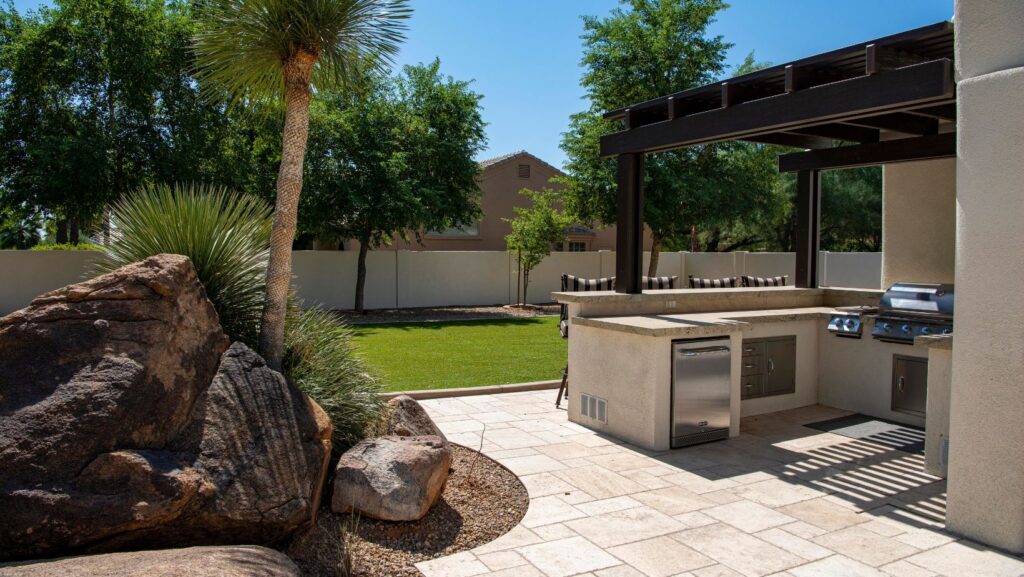An outdoor kitchen can be more than just a place to cook. Done well, it becomes an architectural feature in its own right, blending functionality with open-air aesthetics and extending the living space beyond the traditional footprint of the home.
From courtyards in Fitzroy to breezy verandahs in Byron, Australians are increasingly embracing alfresco living. For architects and designers, the outdoor kitchen presents an exciting design challenge. Despite being a challenge, it’s one that invites us to reconsider how we define the edge between indoors and out.
The Core of the Space
The first decision is purpose. Will the space be for entertaining on weekends, hosting large groups, or quiet weekday dinners for two? The answer shapes not just the layout, but also the infrastructure required.
Key zones need to be planned with intention. These typically include food prep, cooking, serving, and cleaning. Ideally, the workflow between each should be seamless. Consider how bench heights and traffic flow might shift if the kitchen backs onto a pool area, a dining zone, or a vertical garden.
Material Selection for Outdoor Durability
Outdoor spaces demand a more rigorous approach to material selection. Benchtops and cabinetry need to withstand fluctuating temperatures, rain, humidity, and in some cases, salt spray. Stainless steel remains a strong choice, but timber-look finishes and engineered stone now offer more design-forward alternatives with similar resilience.
Flooring is another consideration. Non-slip porcelain tiles, concrete pavers, or treated hardwood can help unify the kitchen with adjacent landscaping while providing durability underfoot.
Gas, Power, and Plumbing: The Architectural Layer
While the finishings catch the eye, infrastructure does the heavy lifting. Power points need to be weatherproof and accessible. Plumbing should be planned early, especially if the space includes a sink or bar fridge.
Gas, in particular, should be approached with both form and function in mind. A built-in barbecue requires planning for bottle placement or direct gas connection. When selecting bottles, size will depend on the frequency of use and available space. It’s wise to refer to a gas bottle size chart early in the design process, so cabinetry and ventilation can be adjusted accordingly.
A good rule of thumb is to locate the gas bottles in a well-ventilated, easy-to-access area that remains discreet within the visual landscape.
Shade and Shelter
Not every outdoor kitchen needs a roof, but some form of weather protection will extend its lifespan and comfort. Consider retractable awnings, louvred pergolas, or fixed structures that allow light while shielding from rain and UV.
Glass canopies and vertical screens are increasingly popular in contemporary designs. These help control exposure without closing off the space entirely. Done right, shelter becomes a sculptural element that elevates the architectural rhythm of the home.
Lighting and Ambience
Lighting should be layered, just like in a traditional kitchen. Task lighting is essential for cooking areas, while ambient lighting can create warmth and atmosphere. Uplighting nearby landscaping or introducing LED strips under benches can add subtle sophistication and improve usability after dark.
As with all electrical planning, work closely with a qualified contractor to ensure compliance with safety standards and local codes.
Sustainability in Outdoor Design
Sustainable outdoor kitchens are not only possible, but increasingly preferred. Water-efficient taps, gas over charcoal for lower emissions, and solar-powered lighting can reduce the environmental footprint.
Incorporating recycled or reclaimed materials, from timber sleepers to salvaged bricks, brings texture and storytelling to the space while reducing demand on new resources.
Final Thoughts
An outdoor kitchen is more than a trend. It’s a response to climate, culture, and lifestyle, particularly in Australia where outdoor entertaining is a way of life. For architects and designers, it’s an opportunity to push the boundary of the built environment, literally and figuratively.
Whether you’re designing for a new build or retrofitting into an existing deck, an outdoor kitchen should feel purposeful, permanent, and well integrated into the whole property. And as with any successful architectural project, it’s the early planning, not just the aesthetics, that ensures long-term satisfaction.



More Stories
How Material Innovation Is Influencing Contemporary Design Objects
How Automation and Smart Tools Are Transforming Architectural Practice
Why Turnkey Sweepstakes Software Is Catching On Fast